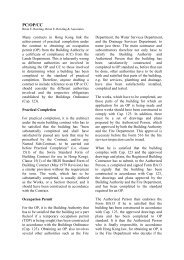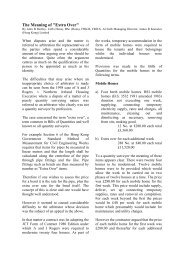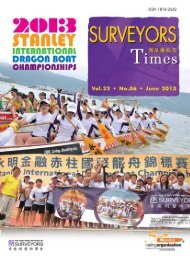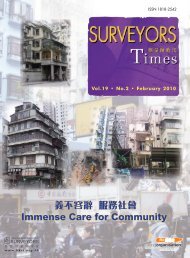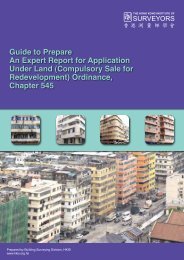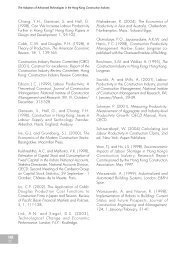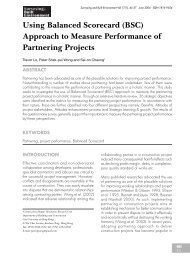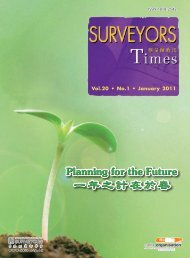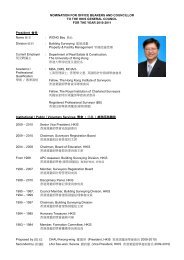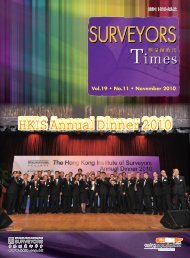Surveying & Built Environment Vol. 22 Issue 1 (December 2012)
Surveying & Built Environment Vol. 22 Issue 1 (December 2012)
Surveying & Built Environment Vol. 22 Issue 1 (December 2012)
Create successful ePaper yourself
Turn your PDF publications into a flip-book with our unique Google optimized e-Paper software.
SBE<br />
28<br />
Reconstructing The Early History of the Gin Drinker’s Line from Archival Sources<br />
envisaged was not a continuous line<br />
per se; it consisted of four stand-alone<br />
“defended localities” each manned by<br />
more or less a battalion and supported<br />
by artillery. The idea of “defended<br />
localities” emerged during the First<br />
World War. To prevent penetration by<br />
the enemy, defenders usually deployed<br />
in depth rather than in line. Positions<br />
were held not by separate lines of<br />
defence but by a series of interlocking<br />
and mutually-supporting positions<br />
spread across a specific area. The term<br />
“defended localities” first appeared<br />
in the Manual of Field Works of 1925<br />
to describe a group of mutuallysupporting<br />
positions forming one large<br />
defended area. 32 Such localities would<br />
be clustered around a dominant position<br />
or on terrain that prevented further<br />
advance by the enemy.<br />
From figure 1, one can see that each<br />
Sector is itself a locality around a<br />
group of mountains and together they<br />
form a large defensive “belt”. The JPC<br />
estimated in 1930 (see above) that the<br />
Japanese would approach the Line<br />
from mainly two sides: from the north<br />
through Shatin or from the west along<br />
the Frontier and Castle Peak Roads.<br />
Those attacking from the north would<br />
be blocked by Sectors 2 and 3, while<br />
those from the west would be fended<br />
off by Sector 4. Barron suggested that<br />
“three of these sectors must be strongly<br />
held, but so long as there are fixed<br />
seaward defences covering Port Shelter<br />
by day and night, the Right Sector can<br />
be left comparatively weak.” 33 Thus,<br />
Barron approved the design of the Line<br />
based on the assumption that its right<br />
flank at Sai Kung would be covered<br />
by the proposed coastal guns at Junk<br />
Bay. However, no actual work had<br />
been carried out, and the whole idea<br />
of defending Kowloon and the New<br />
Territories was dropped altogether in<br />
1938.<br />
The term “Inner Line” was only<br />
adopted officially in February 1937,<br />
after the Defence Scheme of 1936 was<br />
adopted. 34 Concurrently, the Hong<br />
Kong-mainland border was designated<br />
as the Outer Line, and the area between<br />
the Outer and Inner lines was known as<br />
the Intermediate Position, and was also<br />
divided into four sectors. After that,<br />
although the specific time and order<br />
for the change has yet to be found, the<br />
pillboxes of the Line were numbered in<br />
groups, with the first digits of 1, 2, 3,<br />
and 4 denoting the number of “defended<br />
localities” of the Line. 35 It was proposed<br />
by General Bartholomew that the<br />
garrison of the line should not be “less<br />
than four battalions,” of which three<br />
32 Manual of Field Works (All Arms) 1921 (Provisional), London: HM Stationary Office, 1925, pp.82-83<br />
and 86. It is important to note that the Manual specifies that “Each defence post within a locality must<br />
afford support to its neighbours, and be connected up by communication trenches on flanks and rear.”<br />
33 WO 106/111, 18.<br />
34 “Extract from D. O. Letter d/-13.2.37 from Col. Harrison, Hong Kong,” 13/2/1937, WO 106/2363.<br />
35 It seems that the 1, 2, 3, 4 numbering system was introduced only after some of the pillboxes were<br />
built, as the surviving early reports used a different 2-digit system which started with “5”. See “Work<br />
Completed on Gin Drinker’s Line,” circa 1936, WO 106/2363; “Report of the Director of Public Works<br />
for the Year 1937,” Annual Report 1937, 55; also see Lai LWC, Davies SNG, Ching KST, Wong CTC<br />
(2011), Decoding the Enigma of the Fall of the Shing Mun Redoubt Using Line of Sight Analysis, 23.




